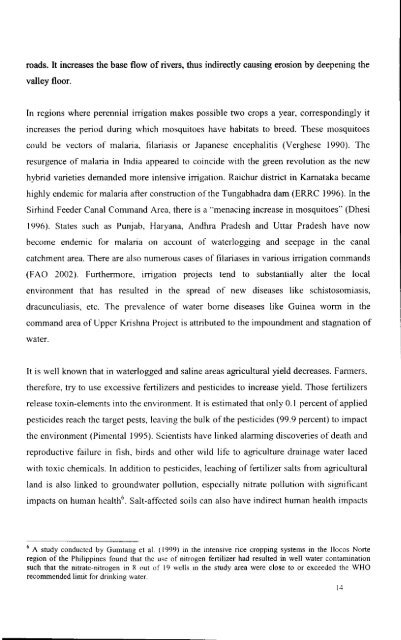Water Users Association and Irrigation Management - Institute for ...
Water Users Association and Irrigation Management - Institute for ...
Water Users Association and Irrigation Management - Institute for ...
Create successful ePaper yourself
Turn your PDF publications into a flip-book with our unique Google optimized e-Paper software.
oads. It increases the base flow of rivers, thus indirectly causing erosion by deepening the<br />
valley floor.<br />
In regions where perennial irrigation makes possible two crops a year, correspondingly it<br />
increases the period during which mosquitoes have habitats to breed. These mosquitoes<br />
could be vectors of malaria, filariasis or Japanese encephalitis (Verghese 1990). The<br />
resurgence of malaria in India appeared to coincide with the green revolution as the new<br />
hybrid varieties dem<strong>and</strong>ed more intensive irrigation. Raichur district in Kamataka became<br />
highly endemic <strong>for</strong> malaria after construction of the Tungabhadra dam (ERRC 1996). In the<br />
Sirhind Feeder Canal Comm<strong>and</strong> Area, there is a "menacing increase in mosquitoes" (Dhesi<br />
1996). States such as Punjab, Haryana, Andhra Pradesh <strong>and</strong> Uttar Pradesh have now<br />
become endemic <strong>for</strong> malaria on account of waterlogging <strong>and</strong> seepage in the canal<br />
catchment area. There are also numerous cases of filariases in various irrigation comm<strong>and</strong>s<br />
(FAO 2002). Furthermore, irrigation projects tend to substantially alter the local<br />
environment that has resulted in the spread of new diseases like schistosomiasis,<br />
dracunculiasis, etc. The prevalence of water borne diseases like Guinea worm in the<br />
comm<strong>and</strong> area of Uppcr Krishna Project is attributed to the impoundment <strong>and</strong> stagnation of<br />
water.<br />
It is well known that in waterlogged <strong>and</strong> saline areas agricultural yield decreases. Farmers,<br />
there<strong>for</strong>e, try to use excessive fertilizers <strong>and</strong> pesticides to increase yield. Those fertilizers<br />
release toxin-elemcnts into the environment. It is estimated that only 0.1 percent of applied<br />
pesticides reach the target pests, leaving the bulk of the pesticides (99.9 percent) to impact<br />
the environment (Pimental 1995). Scientists have linked alarming discoveries of death <strong>and</strong><br />
reproductive failure in fish, birds <strong>and</strong> other wild life to agriculture drainage water laced<br />
with toxic chemicals. In addition to pesticides, leaching of fertilizer salts from agricultural<br />
l<strong>and</strong> is also linked to groundwater pollution, espccially nitrate pollution with signi ficant<br />
impacts on human health 6 . Salt-affected soils can also have indirect human health impacts<br />
6 A study conducted by Gumtang et al. (1999) in the intensive rice cropping systems in the !locos Norte<br />
region of the Philippines found that thc use of nitrogen tertilizer had resulted in well water contamination<br />
such that the nitrate· nitrogen in R out of 19 wells in the study area were close to or exceeded the WHO<br />
recommended limit <strong>for</strong> drinking water.<br />
14
















